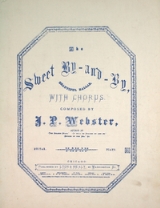
In the Sweet By and By
Encyclopedia
"The Sweet By-and-By" is a Christian
Christian
A Christian is a person who adheres to Christianity, an Abrahamic, monotheistic religion based on the life and teachings of Jesus of Nazareth as recorded in the Canonical gospels and the letters of the New Testament...
hymn
Hymn
A hymn is a type of song, usually religious, specifically written for the purpose of praise, adoration or prayer, and typically addressed to a deity or deities, or to a prominent figure or personification...
with lyrics by S. Fillmore Bennett and music by Joseph P. Webster. It is recognizable by its chorus:
- In the sweet by and by
- We shall meet on that beautiful shore.
- In the sweet by and by
- We shall meet on that beautiful shore.
Background
Mr. Webster, like many musicians, was of an exceedingly nervous and sensitive nature, and subject to periods of depression, in which he looked upon the dark side of all things in life. I had learned his peculiarities so well that on meeting him I could tell at a glance if he was melancholy, and had found that I could rouse him up by giving him a new song to work on.
He came into my place of business [in Elkhorn, Wisconsin], walked down to the stove, and turned his back on me without speaking. I was at my desk. Turning to him, I said, “Webster, what is the matter now?” “It’s no matter,” he replied, “it will be all right by and by.” The idea of the hymn came me like a flash of sunlight, and I replied, “The Sweet By and By! Why would not that make a good hymn?” “Maybe it would,” he said indifferently. Turning to my desk I penned the words of the hymn as fast as I could write. I handed the words to Webster. As he read his eyes kindled, and stepping to the desk he began writing the notes. Taking his violin, he played the melody and then jotted down the notes of the chorus. It was not over thirty minutes from the time I took my pen to write the words before two friends with Webster and myself were singing the hymn.—Sanford Fillmore Bennett (1836-1898)
Other uses
The composer Charles IvesCharles Ives
Charles Edward Ives was an American modernist composer. He is one of the first American composers of international renown, though Ives' music was largely ignored during his life, and many of his works went unperformed for many years. Over time, Ives came to be regarded as an "American Original"...
made use of the tune on several occasions, most notably in the last movement of his Orchestral Set No. 2, written between 1915 and 1919.
During the American Civil War, veterans sang a song devoted to "The Army Bean" which used a tune of which "The Sweet By-and-By" is derivative.
The song was parodied in 1911 as "The Preacher and the Slave
The Preacher and the Slave
"The Preacher and the Slave" is a song written by Joe Hill in 1911. It was written as a parody of the hymn "In the Sweet Bye and Bye". The Industrial Workers of the World concentrated much of its labor trying to organize migrant workers in lumber and construction camps...
". It also appeared in the Academy Award winning movie Sergeant York
Sergeant York
Sergeant York is a 1941 biographical film about the life of Alvin York, the most-decorated American soldier of World War I. It was directed by Howard Hawks and was the highest-grossing film of the year....
(1941) and in Benny and Joon.
In the New Orleans musical tradition, it is a standard dirge
Dirge
A dirge is a somber song expressing mourning or grief, such as would be appropriate for performance at a funeral. A lament. The English word "dirge" is derived from the Latin Dirige, Domine, Deus meus, in conspectu tuo viam meam , the first words of the first antiphon in the Matins of the Office...
at so called "jazz funeral
Jazz funeral
Jazz funeral is a common name for a funeral tradition with music which developed in New Orleans, Louisiana.The term "jazz funeral" was long in use by observers from elsewhere, but was generally disdained as inappropriate by most New Orleans musicians and practitioners of the tradition...
s".
Andrés C. Gonzalez an early Latter-day Saint missionary in Mexico was not allowed to sing this hymn in a public location and was put in jail without trial during the Mexican Revolution
Mexican Revolution
The Mexican Revolution was a major armed struggle that started in 1910, with an uprising led by Francisco I. Madero against longtime autocrat Porfirio Díaz. The Revolution was characterized by several socialist, liberal, anarchist, populist, and agrarianist movements. Over time the Revolution...
. While in jail he wrote Spanish lyrics to accompany the same music. He was allowed to sing the modified version. This same version continues in the current LDS hymnal under the name "Placentero nos es trabajar". It is not included in the current English Hymnal but perhaps in older versions. This version has become a beloved hymn among Latin American Latter-day Saint Christians
External links
- "In The Sweet By And By", Artisan Band (2006-08-13: Artisan iMix 2.0 Bluegrass Week)(CC2.5)—Internet Archive.
- Words, sheet music & MIDI at the Cyber Hymnal
- In the Sweet By and By - Free Piano MP3 at HymnPod
- French adaptation on YouTubeYouTubeYouTube is a video-sharing website, created by three former PayPal employees in February 2005, on which users can upload, view and share videos....

